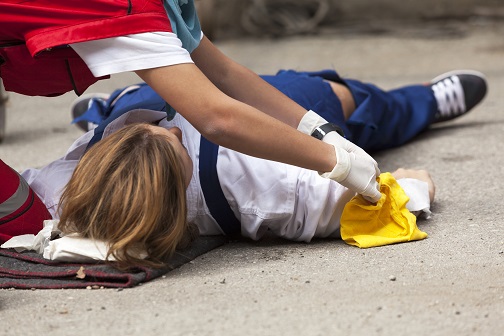Written by Colette Horgan, Chris Mee Group Quality & Training Manager and CFR instructor Martin Ahern
It is estimated that each day in Ireland roughly 13 people collapse from an out of hospital cardiac arrest, these statistics are stark! However, what is even more shocking, is that out of those 13 people that collapse, on average, only one of them will survive. These are just estimates, each year an Out Of Hospital Cardiac Arrest Register reports on the actual number of persons where CPR was performed. In 2019 that number was 2,564. In some cases, CPR is not administered, so in that instance the number is not recorded on the register.
That is roughly 12 to 13 families a day that suffer the trauma of losing a loved one, families that wake up in the morning thinking that its just a normal day when in fact it could turn out to be one of the worst days of their lives.
CPR however can make a big difference to that outcome, prompt recognition and early intervention with good quality CPR, combined with the use of a defibrillator can make a big difference. And that number is going in the right direction. There has been a 17% increase in CPR administered by a bystander and a 12% increase in that bystander using a defibrillator.
Now comes the tricky part…..
Attempting to resuscitate someone who you think may have Covid-19, or you are worried about the risk that you may contract Corona Virus due to the administration of CPR.

The Facts
At the time of writing this blog, there is no known case in the world where a person has become infected with COVID-19 while acting as a lay rescuer to a cardiac arrest.
Even though thousands of people in Ireland have tested positive for COVID-19 since the beginning of 2020, the chance that any individual person who has a cardiac arrest has COVID-19 at the time they have the cardiac arrest is low but there is no way to be sure.
COVID‐19, is an airborne virus, it infects through droplets and contact with the mucous membranes. It does not infect through the skin.
The greatest risk for a responder is transfer of the virus to the mucous membranes in the eyes, nose, or mouth from contaminated hands. So it is important to minimise hand contamination by cleaning your hands frequently (with soap and water or alcohol hand‐rub) and avoid touching your face at all times. The closer you are to the patient the greater the risk of direct transfer of the virus from droplets generated from the patient’s respiratory tract landing directly in your eyes, nose, or mouth.
Administering CPR during Covid-19
So now we know that there is a risk, but how can we minimize it?
Always start with the basics, make sure the scene is safe before you enter. If there is anyone there who may know the person’s medical history, ask! The more information you can get the better informed your decision will be.
The most recent advice from the Pre Hospital Emergency Care Council specifically lists the appropriate types of PPE that you should be wearing when carrying out CPR in the workplace and here at CMSE Training we are best placed to inform and advise you on what to wear and when to wear it.
However, what if you have no PPE? then I advise following these simple steps
Here is the most up to date advice to minimise risk and improve safety for all involved:
- At all times keep your hands away from your face.
- If a person has collapsed in a public space, do look for signs of breathing and signs of life.
- Don’t listen or feel for breathing by placing your ear and cheek close to the person’s mouth.
- Dial 112 or 999 and ask for an ambulance. If COVID-19 is suspected, tell them when you call.
- Use an AED as soon as possible. This significantly increases the person’s chances of survival. Place the AED pads on the person’s chest and apply a shock, if prompted by the AED. This is a safe procedure and should be attempted by a first responder.
- Perform chest compressions only. Do not give mouth to mouth rescue breaths. If there is a perceived risk of infection, you should place a cloth/towel over the person’s mouth and nose (this may help to reduce dispersion of droplets from their airway) and attempt compression-only CPR and early defibrillation until help arrives.
- Afterwards, clean your hands using soap and water or an alcohol-based hand sanitizer. Clean and disinfect the AED if used.
CMSE Training is a leading provider of Irish Heart Foundation registered and PHECC accredited Occupational first aid training courses. Consequently, they are fully recognised by the Health and Safety Authority (HSA).
Courses Include:
- First Aid Responder (FAR) Course
- First Aid Refresher Course
- First Aid Responder (FAR) Instructor Course
- Cardiac First Response (CFR) Course
- Cardiac First Response (CFR) Instructor Course
- Emergency First Aid Course
- Defibrillator (AED) Course
Sources:
https://www.hpsc.ie/a-z/respiratory/coronavirus/novelcoronavirus/guidance/layrescuersguidance/
https://www.hse.ie/eng/services/news/media/pressrel/covid-19-hse-advice-on-performing-cpr-cardiopulmonary-resuscitation-cpr-in-the-community.html
